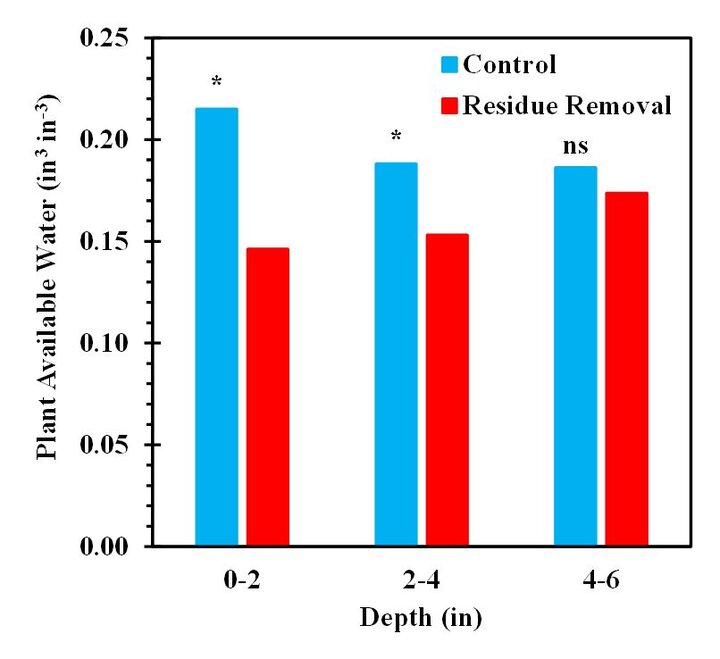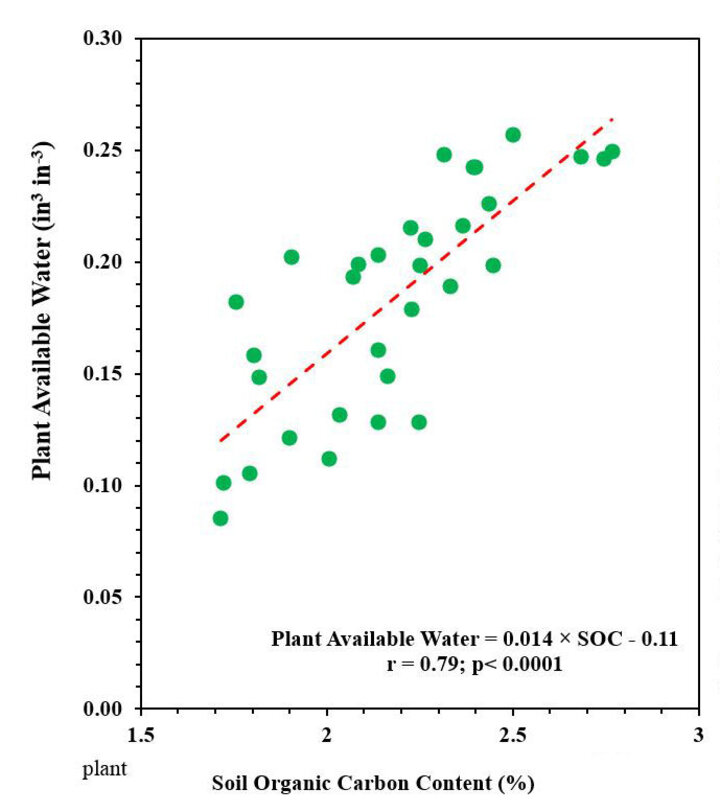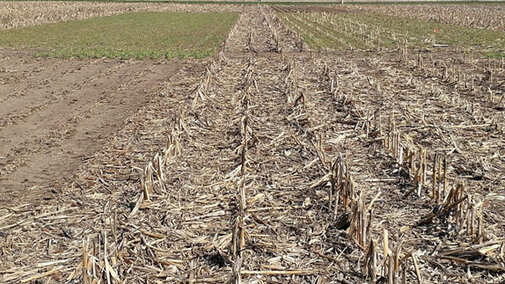How you manage your soil today could have impacts on the productivity of your soil in the near and distant future. Water infiltration and plant available water are two important soil hydraulic properties to manage in the central Great Plains region where rainfall is often supplemented using irrigation to meet plant production goals. Both water infiltration and plant available water are affected by plant residue management, cover crop use, and tillage. The focus of this article will be on how plant residue management and cover crop use affect water infiltration and plant available water.
Why are water infiltration and plant available water important to this region, especially to Nebraska?
Plant available water is the volume of water that is held against gravity but can be removed from the soil by plants. Water infiltration is the rate or amount of water that enters the soil. Any water that does not infiltrate into the soil is lost from a field as runoff or evaporation. Managing both water infiltration and plant available water will be key to keeping fields productive, mitigating drought and floods, and reducing soil loss due to water erosion. This will be accomplished by increasing the rate at which water enters the soil and the amount of water the soil can store, thereby decreasing runoff. Plant available water can be thought of as a water tank from which plants can remove water. The larger the volume of plant available water stored by your soil, the more water available for plant use through the growing season.
How can we increase water infiltration and plant available water?
We can do this by improving or maintaining soil structure and soil organic carbon. Soil organic carbon functions as a binding agent for soil particles to hold together as aggregates. Now you are probably thinking “Great! So how do I manage soil structure?” Previous research suggests that this can be done through managing surface plant residues and/or planting cover crops after harvest.
How does plant residue management affect soil structure, plant available water, and water infiltration?
Research from Ohio State University and the University of Nebraska–Lincoln has found that when removing high amounts of of residue (more than 50%), plant available water was decreased in as little as one year when all residue is removed and within four years when about 60% is removed. Additionally, after removing approximately 60% of the corn residue for six years, plant available water decreased from 1.61 inches to 1.21 inches per 4 inches of soil in south central Nebraska. The decrease in plant available water also can be seen in Figure 2 where aggressive residue removal decreased plant available water in the 0-to-2 inch and 2-to-4 inch soil depths. This research comes from an irrigated continuous corn rotation. (No data is currently available on how a corn-soybean rotation would alter the residue removal effect on plant available water.) However, residue removal did not just decrease plant available water; it also reduced water infiltration. Figure 3 shows how, after six years of removing 60% of corn residue, the rate of water infiltration into the soil decreased from 2.13 inches per hour to 1.43 inches per hour. In short, residue removal caused the soil to allow less water to enter the soil and less water to be available for plant use in between rain and irrigation events. That could mean greater loss of water in runoff rather than being stored in the soil to support crop growth.
How do cover crops affect plant available water and water infiltration?
Long-term, 12-year experiments in Kansas and Maryland have found that cover crops do increase water infiltration. Cover crops were found to increase plant available water after 12 years in an experiment in Iowa using cereal rye and in Kanas using legume cover crops. In Nebraska research, after six years, cover crop use did not increase water infiltration, but we expect to see an effect in the longer term.
So, can cover crops mitigate or offset the negative effects of corn residue removal on water infiltration and plant available water content?
After six years of research in south central Nebraska, cover crops had no effect on plant available water or on water infiltration; however, they did partially offset soil carbon losses caused by aggressive corn residue removal.
The positive relationship between plant available water and soil organic carbon is due to the greater water absorption capacity of organic particles compared with inorganic particles. Also, as you increase soil organic carbon, soil aggregates become more stable and can support more pore spaces that can store more plant available water. As soil carbon is lost from the soil, the aggregates become weaker and the larger pore spaces collapse into smaller pores, decreasing water storage capacity of the soil for plant use. Therefore, if soil organic carbon is lost from the soil, plant available water is lost from the soil. Unfortunately, it is easier to lose carbon than build carbon in soils.



Why are we interested in both soil organic carbon and plant available water?
Because plant available water is positively correlated with soil organic carbon. Figure 4 illustrates the positive relationship between plant available water and soil carbon from six years of Nebraska research. The positive relationship between plant available water and soil organic carbon is due to the greater water absorption capacity of organic particles compared with inorganic particles.
Also, as you increase soil organic carbon, soil aggregates become more stable and can support more pore spaces that can store more plant available water. As soil carbon is lost from the soil, the aggregates become weaker and the larger pore spaces collapse into smaller pores, decreasing water storage capacity of the soil for plant use. Therefore, if soil organic carbon is lost from the soil, plant available water is lost from the soil. Unfortunately, it is easier to lose carbon than build carbon in soils.
Summary
It is very easy to rapidly lose plant available water and soil organic carbon when removing plant residues. However, it takes time (more than 10 years) to increase soil organic carbon in the soil and improve the soil structure to increase plant available water. The same is true for water infiltration. Table 1 shows that soil aggregate stability and organic carbon can decrease in just three years due to high rates of corn residue removal, but their restoration with cover crops may take much longer. This means that management decisions made now will affect the future productivity of your field and the sustainability of your farming operation.
| Soil Properties | Cover Crops After 3 yrs | Cover Crops After 6 yrs | Crop Residue Removal After 3 yrs | Crop Residue Removal After 6 yrs |
|---|---|---|---|---|
| Water Infiltration | No | No | No | Reduced |
| Water Retention | No | No | No | Reduced |
| Available Water | No | No | No | Reduced |
| Wet Aggregate Stability | No | No | Reduced (0-1 inch) |
Reduced (0-6 inches) |
| Organic C | No | Increased | Reduced (0-1 inch) |
Reduced (0-8 inches) |

